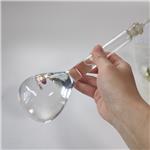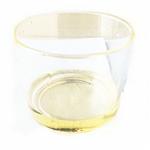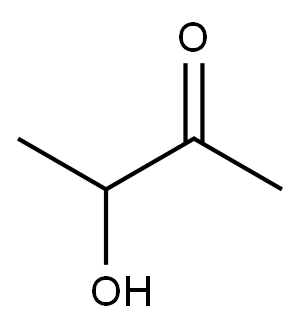- Acetoin
-

- $0.00 / 1KG
-
2023-09-06
- CAS:513-86-0
- Min. Order: 1KG
- Purity: 99%
- Supply Ability: 500000kg
- Acetoin
-

- $0.00 / 25KG
-
2023-06-30
- CAS:513-86-0
- Min. Order: 1KG
- Purity: 99%
- Supply Ability: 50000KG/month
- Acetoin
-

- $0.00 / 1kg
-
2023-06-03
- CAS:513-86-0
- Min. Order: 1kg
- Purity: 99%
- Supply Ability: 500000kg
|
| Product Name: | Acetoin | | Synonyms: | Acetyl methyl carbinol, 85 wt. % solution in water;Acetyl methyl carbinol, pract., 93%;acetoin,3-hydroxy-2-butanone,hydroxybutanone;3-hydroxy-2-butanone, monomer + dimer;BUTAN-2-OL-3-ONE;ACETOIN NATUERLICH (DIMER);3-Hydroxy-2-butanone Solution, 100ppm;(±)-3-Hydroxybutan-2-on | | CAS: | 513-86-0 | | MF: | C4H8O2 | | MW: | 88.11 | | EINECS: | 208-174-1 | | Product Categories: | ketone Flavor;ketone;Pharmaceutical Raw Materials;Other APIs;bc0001 | | Mol File: | 513-86-0.mol |  |
| | Acetoin Chemical Properties |
| Melting point | 15 °C (monomer) | | Boiling point | 148 °C(lit.) | | density | 1.013 g/mL at 25 °C(lit.) | | vapor pressure | 86hPa at 20℃ | | FEMA | 2008 | ACETOIN | | refractive index | n20/D 1.417(lit.) | | Fp | 123 °F | | storage temp. | 2-8°C | | solubility | H2O: 0.1 g/mL, clear | | form | Liquid (Monomer) or Powder or Crystals (Dimer) | | pka | 13.21±0.20(Predicted) | | color | Pale yellow to green-yellow or white to yellow | | Odor | buttery odor | | Odor Type | buttery | | Water Solubility | SOLUBLE | | Merck | 14,64 | | JECFA Number | 405 | | BRN | 385636 | | Stability: | Hygroscopic | | InChIKey | ROWKJAVDOGWPAT-UHFFFAOYSA-N | | LogP | 0.1 at 25℃ | | CAS DataBase Reference | 513-86-0(CAS DataBase Reference) | | NIST Chemistry Reference | 2-Butanone, 3-hydroxy-(513-86-0) | | EPA Substance Registry System | 2-Butanone, 3-hydroxy- (513-86-0) |
| | Acetoin Usage And Synthesis |
| Content analysis | It was determined by gas chromatography (GT-10). Use thermal conductivity detector. Use a column of 1.5 m (length), 6.35 mm (inner diameter). The column contains 20% polyethylene glycol 20M (Carbowax 20M) which is loaded on the 60/80 mesh diatomaceous earth carrier. Alternatively we can use other components that can separate diacetyl, water and methylacetyl alcohol. The following conditions were used: the sample was 2 μg; the injection temperature was about 195 ° C; the column temperature was about 130 ° C and the detector was about 230 ° C; the flow rate of the carrier gas was about 35 ml per minute. The average residence time: 2 min 15S for diacetyl, 3 min for water, and 12 mins for methyl acetyl alcohol. The peak area of the resulting methylacetyl alcohol shall not be less than 96.0% of the total area of all peaks.
| | As a flavor ingredient | Acetoin is a yellowish liquid with a bland, woody, yogurt odor and a fatty creamy “tub” butter taste. It is useful as a flavor ingredient in butter, milk, yogurt or strawberry flavors.
Identification:
CAS.No.:
513-86-0
FL.No.:
7.051
FEMA.No.:
2008
NAS.No.:
2008
CoE.No.:
749
EINECS.No.:
208-174-1
JECFA.No.:
405
CoE: Approved. Bev.: 5 ppm; Food: 50 ppm
FDA: 21 CFR 182.60, 184.1848, 582.60
FDA (other): n/a
JECFA: ADI: Acceptable. No safety concern at current levels of intake when used as a flavoring agent (1998).
Reported uses (ppm): (FEMA, 1994)
Alcoholic.beverages
3.1
3.1
Breakfast.cereals
0.67
0.67
Confection,.frosting
21
100
Meat.products
12.29
24.27
Nonalcoholic.beverages
1.8
17
Reconstituted.vegetables
32
200
| | Chemical Properties | clear yellow solution | | Chemical Properties | Acetoin is a yellowish liquid with a bland, woody, yogurt odor and a fatty creamy “tub” butter taste. It is useful as a
flavor ingredient in butter, milk, yogurt or strawberry flavors. | | Occurrence | Reported found in fresh apple, butter, cheddar cheese, coffee, cocoa, honey, wheat bread and wine | | Uses | Used as pharmaceutical intermediates, food spices; mainly for the preparation of cream, dairy, yogurt and strawberry spices. | | Uses | Acetoin is a produced via fermentation of wines, dairy products and sugars by fermentive bacteria. Acetoin is used in food flavoring and fragrances and is also found in some fruits and vegetables. | | Uses | 3-Hydroxy-2-butanone is a chemical used in food flavoring and fragrances. It acts as an intermediate of butanediol cycle in microorganisms. It is used as an aroma carrier in the preparation of flavors and essences. | | Definition | ChEBI: A methyl ketone that is butan-2-one substituted by a hydroxy group at position 3. | | Aroma threshold values | Aroma characteristics at 1.0%: strong buttery and creamy | | Taste threshold values | Taste characteristics at 10 ppm: sweet, creamy, dairy, and butter-like. | | General Description | A light-yellow colored liquid. Slightly denser than water. Hence sinks in water. Boiling point 280°F. Flash point between 100 and 141°F. Used to make other chemicals. | | Air & Water Reactions | Flammable. Slightly soluble in water. | | Reactivity Profile | 3-Hydroxy-2-butanone is a ketone and alcohol. Ketones are reactive with many acids and bases liberating heat and flammable gases (e.g., H2). The amount of heat may be sufficient to start a fire in the unreacted portion of the ketone. Ketones react with reducing agents such as hydrides, alkali metals, and nitrides to produce flammable gas (H2) and heat. Ketones are incompatible with isocyanates, aldehydes, cyanides, peroxides, and anhydrides. They react violently with aldehydes, HNO3, HNO3 + H2O2, and HClO4. Flammable and/or toxic gases are generated by the combination of alcohols with alkali metals, nitrides, and strong reducing agents. They react with oxoacids and carboxylic acids to form esters plus water. Oxidizing agents convert them to aldehydes or ketones. Alcohols exhibit both weak acid and weak base behavior. They may initiate the polymerization of isocyanates and epoxides. | | Health Hazard | Inhalation or contact with material may irritate or burn skin and eyes. Fire may produce irritating, corrosive and/or toxic gases. Vapors may cause dizziness or suffocation. Runoff from fire control may cause pollution. | | Fire Hazard | HIGHLY FLAMMABLE: Will be easily ignited by heat, sparks or flames. Vapors may form explosive mixtures with air. Vapors may travel to source of ignition and flash back. Most vapors are heavier than air. They will spread along ground and collect in low or confined areas (sewers, basements, tanks). Vapor explosion hazard indoors, outdoors or in sewers. Runoff to sewer may create fire or explosion hazard. Containers may explode when heated. Many liquids are lighter than water. | | Safety Profile | Experimental reproductive effects. LWdly toxic by subcutaneous route. A moderate skin irritant. Flammable liquid. When heated to decomposition it emits acrid smoke and fumes. See also KETONES | | Synthesis | From diacetyl by partial reduction with zinc and acid. It is also a product of fermentation. Acetoin is an optically active
compound. The d(–)acetyl methyl carbinol is obtained from fermentation and, in mixture with other products, from the catalytic
oxidation of 2,3-butanediol. The 1(+)acetyl methyl carbinol is also obtained from fermentation. The optically pure form has not been
isolated; the optically inactive form is prepared synthetically | | Purification Methods | Wash acetoin with EtOH until colourless, then with diethyl ether or acetone to remove biacetyl. Dry it in air by suction and dry further in a vacuum desiccator. [Beilstein 1 IV 3991.] |
| | Acetoin Preparation Products And Raw materials |
|